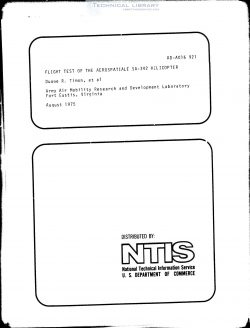USAAMRDL-TR-75-44
- Version
- 273 Downloads
- 3.86 MB File Size
- 1 File Count
- March 7, 2017 Create Date
- March 7, 2017 Last Updated
U.S. Army Air Mobility Research and Development Laboratory - Flight Test of the Aerospatiale SA-342 Helicopter

9. Flight tests were performed on the Model SA-342 helicopter to evaluate performance and handling qualities during hover, translational flight, forward flight, autorotative flight, and maneuvefing flight, Total power required, fan power required, and handling qualities were quantitatively and qualitatively evaluated. In brief summary: total power required for hovering turns in a 10•knot wind varied as much as 50 horsepower (37.3 kilowatts), depending on the direction of the wind; fan power required in hover was approximately 17 percent of total power required, with slightly less fan power required for OGE than for IGE hover; diffi- cuity was experienced in trimminq the aircraft within the sideslip deadband; directional damping was weak in hover; and directional instabilities were experienced while hovering in winds from the right. The Model SA•342 exhibited slightly improved static lateral- directional stability over the Model SA-341 as reported in reference 1, and the improved fan provided sufficient control moment to attain 50 knots in sideward flight.
10. Minimal performance testinq was conducted since the primary objective of the flight tests was to determine the handling qualities effects of configuration changes incorporated in the Model SA•342 helicopter. Engine torque was recorded, from which total power required was determined. Instrumentation for measuring fan thrust was not available, and fan drive shaft torque was recorded only during the last flight. Although it was desired to test at different rotor speeds, all tests were conducted at a constant rotor speed of 387 rpm and a fan speed of 6000 rpm due to the helicopter design characteristics. Hovering and low-speed power-required data were acquired at skid heights of 3 to 5 feet IGE and 75 to 100 feet OGE under the conditions listed in Table 2. Low-speed data were acquired by following a pace car equipped with an anemometer. Due to the time constraints on the evaluation, it was not possible to acquire performance data in calm wind conditions. High altitude tests were performed during the one flight in which fan drive shaft torque instrumentation was installed, but due to uncertainty of wind direction and the rapidly changing wind velocities, the data were partially unusable. Pilot qualitative comments and some averaged quantitative data are discussed in paragraphs 17 and 36. Total power required for hovering turns in a 10•knot wind varied as much as 50 horsepower (37.3 kilowatts), depending on the direction of the wind. Fan power required in hover was approximately 17 percent of total power required, and slightly less fan power was required for OGE than for IGE hover. In forward flight at 140 KIAS, fan power required was less than 5 horsepower (3.7 kilowatts).
| File | Action |
|---|---|
| USAAMRDL-TR-75-44 Flight Test of the Aerospatiale SA-342 Helicopter.pdf | Download |

Comment On This Post